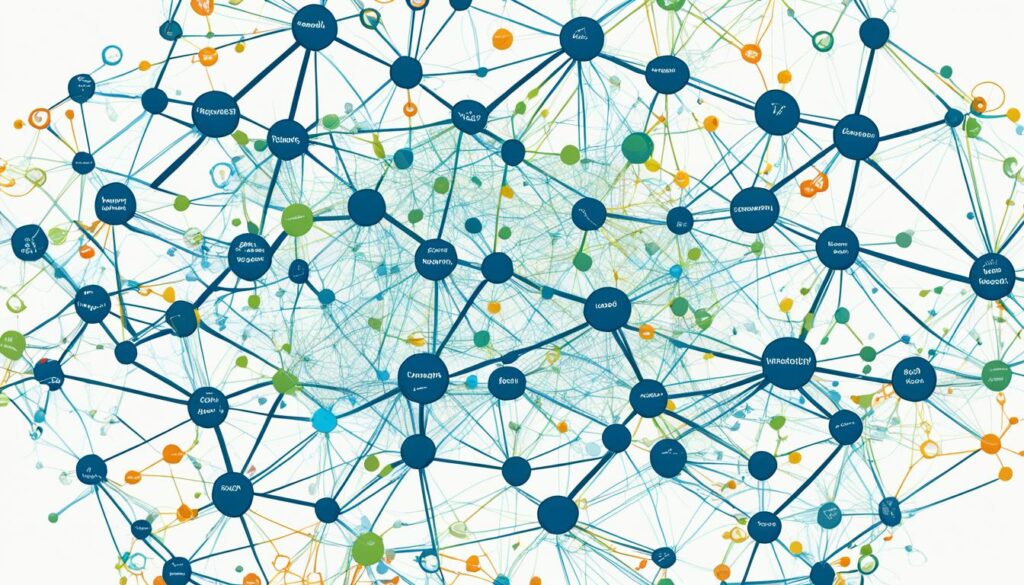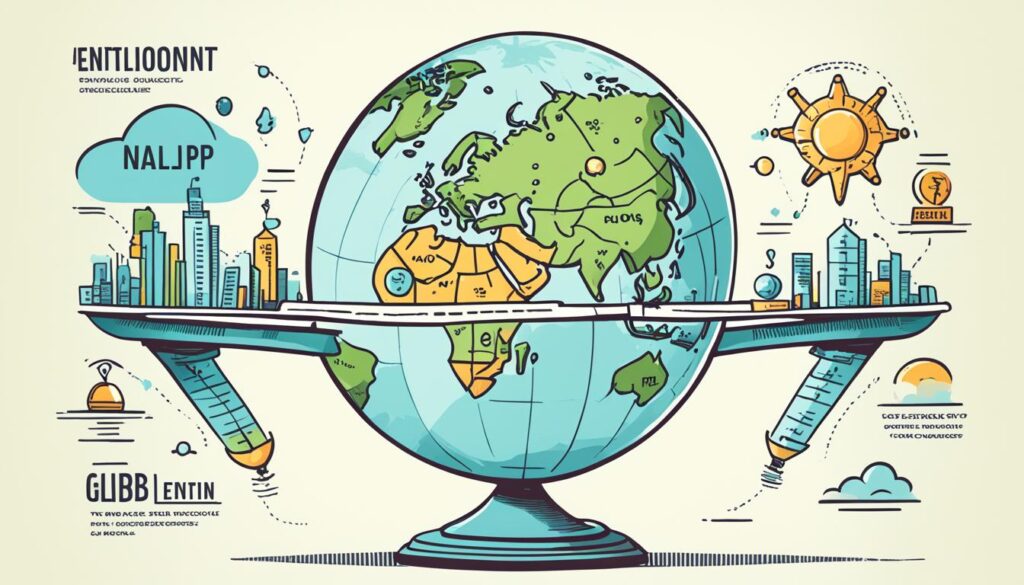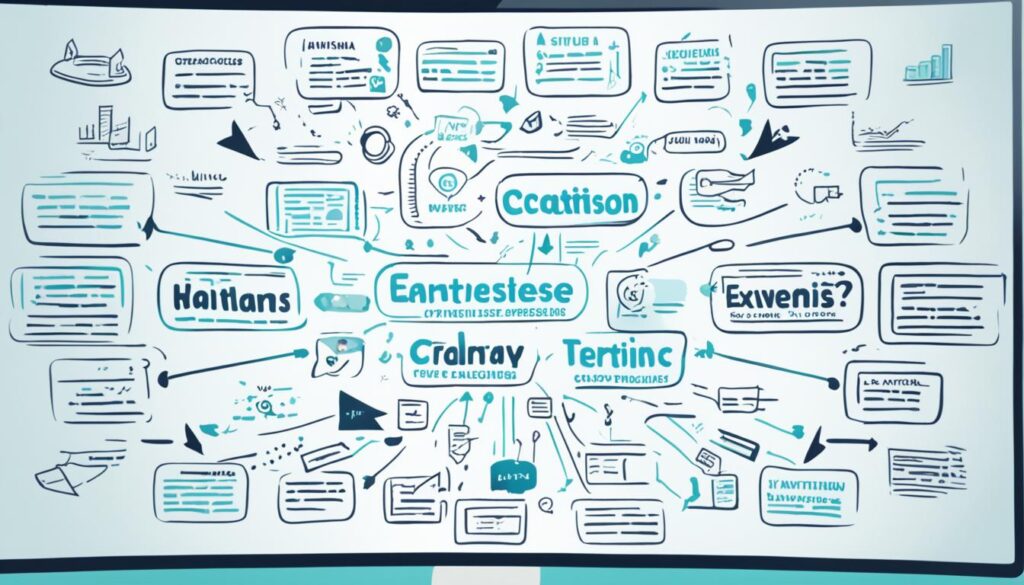Did you know Natural Language Processing (NLP) is a part of Artificial Intelligence (AI)? It changes how machines see and read human language. Thanks to better machine learning and lots of data, NLP is growing fast. It’s used a lot in healthcare, media, finance, and hiring.
NLP helps machines understand and use info from texts, tweets, and talks. It can know the mood or guess what happens next. This is done by splitting text into parts that make sense. NLP makes understanding words more accurate and better.
This article looks at the basics of Natural Language Processing. We will talk about what it is, how machine learning helps, where we use it, and what’s next for NLP.
Key Takeaways:
- NLP is a part of AI focused on teaching machines human languages.
- It uses ideas from linguistics, computer science, and machine learning. This helps make algorithms that read, understand, and respond to what people say or write.
- Important tools in NLP, like breaking down text into parts, help make sense of language more clearly and correctly.
- Machine learning is key in making NLP better. It helps make smarter algorithms that can understand human language more and more.
- NLP helps in many fields, like healthcare and making customer experiences better. It also makes searching better and can help do some jobs automatically.
What is Natural Language Processing?
Natural Language Processing (NLP) is an important part of Artificial Intelligence. It helps machines understand and use human language. NLP uses knowledge from linguistics, computer science, and machine learning.
This technology lets computers understand and react to what people say or write. The main aim of NLP is to make talking to computers feel natural and easy.
In recent times, NLP has grown a lot. This happened because of better machine learning and lots of data available. Now, we have strong NLP models that can do many things. For example, they can analyze emotions in text, summarize information, extract useful data, and even translate languages.
NLP is used in fields like healthcare, customer service, and making automated systems. Learning about NLP helps us see its opportunities and what it can do.
The Cognitive Revolution in Machine Understanding
The Shift from Keyword-Based Interpretation to Cognitive Understanding
The area of Natural Language Processing (NLP) is changing through a big shift in how machines grasp human language. Earlier, machines focused on keywords to understand what was being said. Yet, this old method often missed the real depth and flow of our words.
With the cognitive revolution, things are different. Now, NLP learns more like we do, using advanced tech and learning methods. It tries to understand the meaning behind each word and phrase. This change lets machines pick up on sarcasm, hints, and even emotions in what we say. They are getting better at understanding us, thanks to this new way of learning.
Impact of Unstructured Data on Natural Language Processing Development
Big piles of information are created every day, like chat logs, social posts, and medical notes. Most of this info isn’t easy to organize, which was a challenge for older NLP systems.
Yet, today’s NLP is getting much better at handling this mess of data. They are learning to find the useful bits within it. This skill is boosting NLP’s use in health, finance, and making customer service smarter.
Understanding messy data is a game changer for NLP. It lets machines help us in ways we couldn’t imagine before. For example, they can find health risks by looking at patient records. Or, they can tell how customers feel by checking social posts. This leap is huge for NLP’s growth.
The cognitive turn and handling messy data have pushed NLP forward. As this tech grows smarter, it could bring changes in many fields and make life better for all of us.
Core Techniques in NLP: From Tokenization to Lemmatization
Core techniques play a big role in Natural Language Processing (NLP). They help efficiently process and understand text. Two key techniques are tokenization and lemmatization. Now, let’s learn what each of these does.
Tokenization: Breaking Down Text into Meaningful Units
Tokenization is all about breaking text into smaller parts, or tokens. These tokens can be words, phrases, or letters. This step makes it easier for computers to grasp the text’s structure and meaning.
For NLP, tokenization is vital. It helps with tasks like finding the meaning behind words, spotting important names, and figuring out feelings from text. Breaking down text into tokens makes computer processing more accurate. This allows for better understanding and providing helpful answers.
Lemmatization: Simplifying Words to their Base Form
Lemmatization simplifies words to their most basic form. It finds the base of a word, like “running” to “run”. This makes it easier for NLP systems to analyze texts.
When NLP algorithms lemmatize, they increase accuracy. By doing this, it reduces the number of unique words. This simplification helps NLP systems truly understand the words’ meanings. It pulls out the most important insights from text data.
Tokenization and lemmatization, and also part-of-speech tagging plus grammar analysis, are crucial for NLP. They allow NLP systems to manage lots of text. They provide smart interpretations and accurate responses as well.
Next up, we’ll look at how machine learning influences NLP’s growth and the connection between machine learning and language studies.
Machine Learning’s Role in NLP Evolution
Machine learning is central to the growth of Natural Language Processing (NLP). It helps NLP systems get better at understanding and using human language. Thanks to machine learning, these systems are more accurate and efficient.
The Interplay Between Machine Learning and Linguistics
There’s a strong link between machine learning and linguistics. By using machine learning, computers can recognize patterns and rules in language. Through training on big data, NLP systems can grasp the intricacies of how we use words and sentences.
Improving NLP Accuracy with Advanced ML Algorithms
The use of cutting-edge machine learning algorithms has greatly enhanced NLP’s precision. Techniques like deep learning and transformer models have made major strides in tasks such as translation and sentiment analysis. These innovations help computers understand language more like we do.
As machine learning progresses, NLP will also advance. This means machines will keep getting better at using and understanding human language. This will lead to more advanced ways of communication between humans and machines.
Practical Applications of Natural Language Processing
Natural Language Processing (NLP) is making a big impact across many fields. It helps in improving healthcare, making customer service better, and speeding up tasks in law. Here are a few key uses of NLP:
Enhancing Healthcare Through Predictive NLP
Predictive NLP changes how we look at health. It looks at health records and what patients say to anticipate diseases and make treatments better. By using NLP, doctors can understand a massive amount of health notes and find health trends. This helps doctors take care of patients more effectively and use data to make choices. It can seriously make health care better and push for new discoveries in medicine.
Transforming Customer Experience with Sentiment Analysis
NLP analyses conversations to show how people feel. It looks at emails, social media, and more to see what consumers really think. Then, companies can make smarter choices, improve their offerings, and provide better service that people want. This makes it easier for businesses to know what their customers need and to focus on meeting those needs.
Automating Routine Tasks and Legal Procedures in Corporations
In the business world, NLP is automating routine jobs and dealing with legal tasks. NLP tools can check through legal papers and rules faster than people can. This cuts down on mistakes and saves time. Businesses can run smoother and do work that really matters because of NLP. It makes sure companies follow the law properly too, lessening the chance for mistakes.
NLP has shown its worth in many areas, from health to customer service and making work easier. It’s a valuable tool for finding new insights, making processes better, and bringing smart solutions.
Natural Language Processing in the Information Retrieval Ecosystem
Natural Language Processing (NLP) is key in the search engine world. It helps engines get what users want more clearly and offer the right results. NLP looks at the words, context, and reason behind a search to link it with accurate documents or pages.
Methods like recognizing entities, expanding questions, and understanding meaning boost searches. They help find what the user really wants and get the best information. NLP also aids in sorting emails, spotting spam, and making search results more personal.
As NLP grows, search engines get better at reading complex user questions. This makes finding answers quick and easy for everyone. So, NLP’s role has really changed how we find and use information online.

Understanding Speech Recognition and Its Complexities
Speech recognition is part of NLP. It turns spoken words into written text. It starts by capturing audio data. Then, it breaks it down and understands speech cues and patterns. This needs advanced algorithms.
It is key in transcription services and for virtual assistants. Accurate transcription is crucial for humans to talk with machines. But, there are hurdles it faces too.
From Voice to Text: The Journey of Speech Recognition
The journey from voice to text involves many steps. Audio is first captured with devices like microphones. Then, it’s cleaned to remove noise. The speech is cut into smaller parts for easier analysis.
Advanced algorithms match speech sounds to their database. They consider speech variations and accents to turn speech into text. The process keeps improving for better accuracy and efficiency.
Challenges in Accurately Transcribing Human Speech
Transcribing speech faces many hurdles. Background noise can lower the quality of the audio. This makes it harder to understand the speech.
Every speaker’s unique voice and pronunciation pose challenges. Systems need to adapt to these different styles. This ensures they transcribe accurately.
Words with more than one meaning add extra complexity. They need to be understood within their specific context. This is crucial for correct transcription.
Despite these issues, NLP algorithms are getting better. Research in machine learning is improving how they handle various challenges. This progress is making speech recognition better and more reliable.
Learning about the difficulties of speech recognition shows us how far it has come. It also hints at the potential for future growth.
The Future of NLP: Ethical Considerations and Advancements
In the future, Natural Language Processing (NLP) will affect ethics and tech progress. It’s especially true in healthcare. There, predictive NLP raises questions about protecting patient privacy, consent, and using personal information the right way. As NLP gets better, it’s more important to handle ethical issues well and make sure we use predictive models fairly and transparently.

Navigating the Ethics of Predictive NLP in Healthcare
Healthcare benefits a lot from predictive NLP. It helps predict diseases and improve how we treat patients by looking at their health records and what they say. But, we must be careful about how we use this information. It’s key to set up rules that make sure we protect patient privacy and handle their health data ethically. Balancing tech advances with ethics means predictive NLP can really help patients in a good way.
Emerging Trends and Technologies in Natural Language Processing
The NLP world is also seeing new trends and tech that are helping us understand language better. Things like deep learning, transformer models, and language models that learn before they’re used are changing how NLP works. Now, NLP does better at translating languages, creating texts, figuring out feelings from writing, and handling more complex language jobs. Work on understanding many languages and cultures is also making NLP more open and useful for everyone.
Understanding the ethics of predictive NLP and using new technology can lead to a future where we use language understanding well, responsibly, and for everybody.
Conclusion
Natural Language Processing (NLP) has changed how machines interact with people. It brings many benefits to fields like health care, customer service, and automation. NLP helps computers read and understand human language.
The key methods in NLP, like tokenization and lemmatization, have improved how we understand language. These tools simplify words to help computers make sense of them. This has made NLP better at its job.
But, some issues are still there. For instance, making speech recognition to fully understand human speech is a big challenge. This is crucial for apps like Siri, Google Assistant, and services that write down spoken words.
The horizon of NLP is filled with opportunities. New trends and tools like deep learning and transformer models are enhancing our language understanding. Yet, we must also focus on the ethics, especially in health care predictive NLP. It’s vital to use NLP technology in fair and clear ways.
Learning about NLP helps us see its potential. It guides us to use this technology wisely and in new, creative ways.
For more on Natural Language Processing, check out IBM’s Natural Language Processing page.


Pingback: Explore the Capabilities of Zero ChatGPT Today